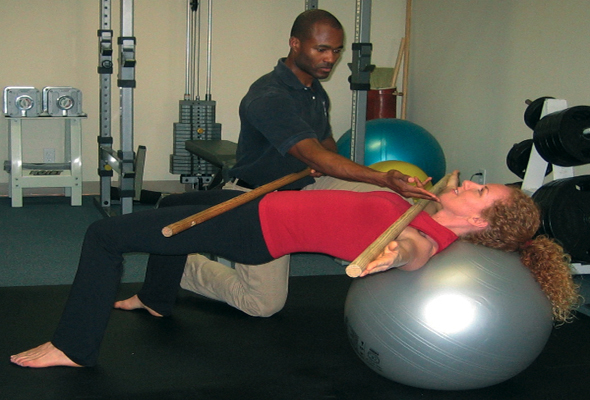Do You “Workout” or Do You Train?
admin
Filed under Corrective Exercise

The “bigger is better philosophy that swept America in the 80’s and 90’s is giving way to a “The new way of thinking when it comes to working out. A way of thinking that contains more substance than flash”. Steve Blechman Editor-in-chief of Fitness Rx magazine, is quoted as saying this I couldn’t agree with him more (October 1999 issue of Muscular development).
Today’s standards not only require you to look good but to perform optimally as well. Blechman also went on to say that adding muscle for the sake of bulk is not the wave of the future. The ability to perform skilled athletic movements is more practical than just adding bulk. It is no coincidence that some of the greatest athletes in the world also have some of the best-built physiques. Their aesthetically pleasing figures are the consequence of years of exposure, to balanced purposeful physical activity. If they would have limited themselves to the use of exercise machines or fixed modes of physical activity, their high level of performance may never have been possible. So what better way to achieve an elite-level body than by emulating their training philosophies. This is the essence of training versus workout out.
In today’s modern world, technology has provided us many ways that we can exercise increase fitness and improve our bodies. There are strength machines, aerobic equipment, the numerous exercise gadgets that range from health riders, , ab rollers, ab doers, ab dollies, ab cruncher, ab stimulator and the many other devices present in the market today. We can also choose methods of exercise such as the pilates method, step aerobics, spinning classes, kickboxing, super-cardio, body sculpting, the list is endless. The intent of all of these machines, gadgets and methods are to improve one’s health and physical fitness levels and to exercise your body. But I am here to tell you that Exercise Doesn’t Work, and here is the reason. All of these techniques are meant to exercise the body but WHAT IF YOUR BODY DOESN’T WORK? What do you when your body does not work? Confused? Keep reading..
More people today live sedentary lifestyles that contribute to a wide range of chronic physical dysfunction in the body. Sedentary lifestyle brings with it obesity, overweight as well as muscle weakness that prevent safe execution of exercise. Millions of people are starting exercise programs when their bodies are not working properly. As a result there is more than 2.8 billion dollars a year is being spent on medical costs related to exercise and weight training injuries according to the US product and safety commission. I question the reason for this. My theory is that first people are starting exercise programs when their bodies just do not work and secondly people are not being taught how to use their bodies properly.
Machines and other modes of exercise the body, but who’s to say that any machine or particular exercise is suitable for everyone. There is nothing that takes into consideration the critical factors such as posture, muscle balance, movement skill and current level of physical conditioning. The reason why most mainstream “workouts” don’t work is that the majority of people have bodies that are not functioning properly on some level.
To make exercise work for the masses, there must be a system in place that will determine TRUE physical readiness. This means evolving beyond the realm of “biceps and triceps” and into the mindset of physiological stress from a hormonal, nutritional, emotional, and musculoskeletal. This is the key step that most people forget to take when selecting an exercise program and is why traditional exercise does not work.
What does work is corrective exercise. Corrective exercise is not a method, exercise class, or quick fix. It is a philosophy that is based on the fact that the body functions best when it is in ideal posture and when all of the body’s basic movement patterns are working properly. The goal of any exercise program should be to improve posture, movement function and mechanics in the body. Unless there is an understanding of how your body is functioning before starting an exercise program, it will be very difficult to select exercises that will restore or improve function.
We are all dynamic in that when we exercise, there is more involved than just muscles. We have nerves, hormones, and internal organs that are also effected by the type of exercise that we do. Even our emotions are effected by exercise. Corrective exercise is about understanding the interactive nature of the body, a holistic approach if you will. Knowing how you will respond to exercise before starting a program puts you in a great position to achieve positive results. In my personal experience, I have evaluated and treated many clients that had been exercising for 5, 10, and even 20 years not knowing that their bodies were not working properly. After a comprehensive assessment and consultation, they can see and even feel the difference between traditional exercise and corrective exercise. Once I take them through specific tests that physically show them the difference between their current movement patterns and what ideal movement is, they realize that for most people traditional exercise does not work. Then I explain that in order to make exercise work for them, they have to first understand their body. This is the philosophy of corrective exercise. Corrective exercise allows you to know your body better and address its needs with specific exercises. This is the type of exercise that works. If you are truly interested in knowing how your body functions and what exercises are best for you, I highly recommend considering a corrective exercise program. C.H.E.K. practitioners have special training on how to assess the body through a comprehensive structure evaluation which includes a posture, orthopedic and movement analysis, thus creating a successful exercise program. ##


